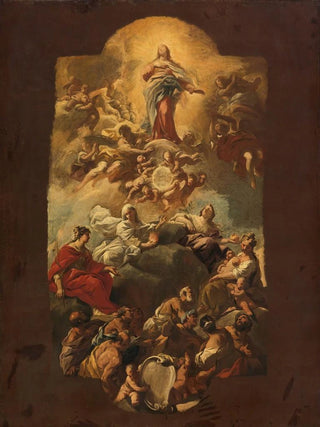Art print | The Assumption of the Virgin - Luca Giordano


View from behind

Frame (optional)
L'Assumption of the Virgin - Luca Giordano – Captivating Introduction
The Assumption of the Virgin, an iconic art print by Luca Giordano, is a true masterpiece embodying the splendor of Baroque art. This canvas, created in the 17th century, depicts a sacred moment when the Virgin Mary is lifted to the heavens, surrounded by a multitude of angels and celestial figures. The work stands out for its dynamism and luminosity, capturing the very essence of spiritual elevation. Through this art print, Giordano's artistic legacy is revealed in all its magnificence, offering an immersion into a universe where faith and art intertwine with rare intensity.
Style and uniqueness of the work
Giordano's style is characterized by an exceptional mastery of movement and light. In The Assumption of the Virgin, the figures seem to float, creating a sensation of elevation that transcends the simple frame of the canvas. The drapery of the garments, rendered with remarkable precision, adds a sense of fluidity and grace to the entire composition. The color palette chosen by the artist, oscillating between warm tones and luminous highlights, contributes to the celestial atmosphere of the scene. Every detail, from facial expressions to the gestures of the characters, is carefully studied, demonstrating a deep understanding of human anatomy and an artistic sensitivity that leaves no one indifferent. This work, with its ability to capture emotion and evoke the sacred, stands as a perfect example of Neapolitan Baroque, where exuberance and spirituality harmonize.
The artist and his influence
Luca Giordano, nicknamed "Luca fa Presto" due to his rapid execution, is a major figure of Baroque art. Born in Naples in 1634, he established himself on the European artistic scene thanks to his undeniable talent and innovative approach. Influenced by great masters such as Caravaggio and Rubens, Giordano developed a personal style that combines technical virtuosity and expressiveness. His career led him to work for numerous royal courts, which testifies

Matte finish

View from behind

Frame (optional)
L'Assumption of the Virgin - Luca Giordano – Captivating Introduction
The Assumption of the Virgin, an iconic art print by Luca Giordano, is a true masterpiece embodying the splendor of Baroque art. This canvas, created in the 17th century, depicts a sacred moment when the Virgin Mary is lifted to the heavens, surrounded by a multitude of angels and celestial figures. The work stands out for its dynamism and luminosity, capturing the very essence of spiritual elevation. Through this art print, Giordano's artistic legacy is revealed in all its magnificence, offering an immersion into a universe where faith and art intertwine with rare intensity.
Style and uniqueness of the work
Giordano's style is characterized by an exceptional mastery of movement and light. In The Assumption of the Virgin, the figures seem to float, creating a sensation of elevation that transcends the simple frame of the canvas. The drapery of the garments, rendered with remarkable precision, adds a sense of fluidity and grace to the entire composition. The color palette chosen by the artist, oscillating between warm tones and luminous highlights, contributes to the celestial atmosphere of the scene. Every detail, from facial expressions to the gestures of the characters, is carefully studied, demonstrating a deep understanding of human anatomy and an artistic sensitivity that leaves no one indifferent. This work, with its ability to capture emotion and evoke the sacred, stands as a perfect example of Neapolitan Baroque, where exuberance and spirituality harmonize.
The artist and his influence
Luca Giordano, nicknamed "Luca fa Presto" due to his rapid execution, is a major figure of Baroque art. Born in Naples in 1634, he established himself on the European artistic scene thanks to his undeniable talent and innovative approach. Influenced by great masters such as Caravaggio and Rubens, Giordano developed a personal style that combines technical virtuosity and expressiveness. His career led him to work for numerous royal courts, which testifies






